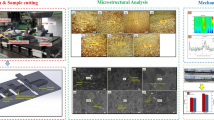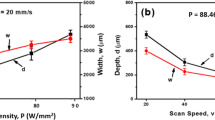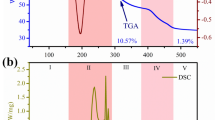Abstract
Machining processes involve thermo-mechanical loading, which influences the tool wear and surface quality. Nano lubricants are effective in reducing the friction between tool-work contact surfaces. However, nanofluids prepared with plant-based oils are more desirable in view of ecological concerns. The present work aims to investigate the machining and tribological performance of novel vegetable oil-based nanofluid. Al2O3 and ZrO nanoparticles have been dispersed in Jatropha oil to develop biodegradable nanofluids and are investigated for their dispersion stability and anti-corrosion characteristics. The prepared nanofluids have been found to be stable for 48 h via UV–vis and zeta potential studies. The anti-corrosion capability of the nanofluids has been confirmed for their suitability in a corrosive environment. Tribological characteristics of the nanofluids have been investigated using a pin-on-disc wear test with Hastelloy C-276 and tungsten carbide mating pair. The experimental findings have shown a noticeable reduction in the coefficient of friction and wear loss. The coefficient of friction has been reduced by 83.3%, 85%, 80%, and 81.6% using JO, JO + 0.5% Al2O3, JO + 0.5% ZrO, and JO + 0.5% Al2O3 + 0.5% ZrO respectively as compared to dry condition. Furthermore, wear loss has been decreased by 51.7%, 72.3%, 61.6% and 73.1% using JO, JO + 0.5% Al2O3, JO + 0.5% ZrO and JO + 0.5% Al2O3 + 0.5% ZrO in comparison with dry condition. Also, the machining performance of nanofluids has shown a significant decrease in cutting forces and surface roughness. The ultrasonically produced atomized mist of nanofluids has resulted in a decrease in tool wear and produces chip segmentation. The prepared unitary and hybrid nanofluids have shown an immense potential to address the environmental concerns of machining difficult-to-cut materials.
Graphical abstract






















Similar content being viewed by others
Data availability
The datasets generated and analyzed during the current experimental study are not publicly available but are available from the corresponding author on reasonable request.
References
Schultheiss F, Zhou J, Gröntoft E, Ståhl JE (2013) Sustainable machining through increasing the cutting tool utilization. J Clean Prod 59:298–307. https://doi.org/10.1016/j.jclepro.2013.06.058
Jayal AD, Badurdeen F, Dillon OW, Jawahir IS (2010) Sustainable manufacturing: modeling and optimization challenges at the product, process and system levels. CIRP J Manuf Sci Technol 2:144–152. https://doi.org/10.1016/j.cirpj.2010.03.006
Singh AK, Kumar A, Sharma V, Kala P (2020) Sustainable techniques in grinding: state of the art review. J Clean Prod. https://doi.org/10.1016/j.jclepro.2020.121876
Pusavec F, Kramar D, Krajnik P, Kopac J (2010) Transitioning to sustainable production-part II: evaluation of sustainable machining technologies. J Clean Prod 18:1211–1221. https://doi.org/10.1016/j.jclepro.2010.01.015
Haapala KR, Zhao F, Camelio J et al (2013) A review of engineering research in sustainable manufacturing. J Manuf Sci Eng Trans ASME 135:1–16. https://doi.org/10.1115/1.4024040
Osama M, Singh A, Walvekar R et al (2017) Recent developments and performance review of metal working fluids. Tribol Int 114:389–401. https://doi.org/10.1016/j.triboint.2017.04.050
Wickramasinghe KC, Sasahara H, Rahim EA, Perera GIP (2020) Green Metalworking Fluids for sustainable machining applications: a review. J Clean Prod 257:120552. https://doi.org/10.1016/j.jclepro.2020.120552
Pervaiz S, Kannan S, Kishawy HA (2018) An extensive review of the water consumption and cutting fluid based sustainability concerns in the metal cutting sector. J Clean Prod 197:134–153. https://doi.org/10.1016/j.jclepro.2018.06.190
Liew PJ, Shaaroni A, Sidik NAC, Yan J (2017) An overview of current status of cutting fluids and cooling techniques of turning hard steel. Int J Heat Mass Transf 114:380–394. https://doi.org/10.1016/j.ijheatmasstransfer.2017.06.077
Shokrani A, Dhokia V, Newman ST (2012) Environmentally conscious machining of difficult-to-machine materials with regard to cutting fluids. Int J Mach Tools Manuf 57:83–101. https://doi.org/10.1016/j.ijmachtools.2012.02.002
Shashidhara YM, Jayaram SR (2010) Vegetable oils as a potential cutting fluid-an evolution. Tribol Int 43:1073–1081. https://doi.org/10.1016/j.triboint.2009.12.065
Lawal SA, Choudhury IA, Nukman Y (2012) Application of vegetable oil-based metalworking fluids in machining ferrous metals-a review. Int J Mach Tools Manuf 52:1–12. https://doi.org/10.1016/j.ijmachtools.2011.09.003
Abdul Sani AS, Rahim EA, Sharif S, Sasahara H (2019) Machining performance of vegetable oil with phosphonium- and ammonium-based ionic liquids via MQL technique. J Clean Prod 209:947–964. https://doi.org/10.1016/j.jclepro.2018.10.317
Nabeel Rashin M, Hemalatha J (2013) Viscosity studies on novel copper oxide-coconut oil nanofluid. Exp Therm Fluid Sci 48:67–72. https://doi.org/10.1016/j.expthermflusci.2013.02.009
Kumar Gajrani K, Ravi Sankar M (2017) Past and current status of eco-friendly vegetable oil based metal cutting fluids. Mater Today Proc 4:3786–3795. https://doi.org/10.1016/j.matpr.2017.02.275
Naik DNS, Sharma V (2022) Thermophysical investigations of mango seed oil as a novel cutting fluid: a sustainable approach toward waste to value addition. J Manuf Sci Eng. https://doi.org/10.1115/1.4054002
Gunan F, Kivak T, Yildirim CV, Sarikaya M (2020) Performance evaluation of MQL with AL2O3 mixed nanofluids prepared at different concentrations in milling of Hastelloy C276 alloy. J Mater Res Technol 9:10386–10400. https://doi.org/10.1016/j.jmrt.2020.07.018
Sah NK, Singh R, Sharma V (2021) Experimental investigations into thermophysical, wettability and tribological characteristics of ionic liquid based metal cutting fluids. J Manuf Process 65:190–205. https://doi.org/10.1016/j.jmapro.2021.03.019
Moreira TA, Moreira DC, Ribatski G (2018) Nanofluids for heat transfer applications: a review. J Braz Soc Mech Sci Eng 40:303. https://doi.org/10.1007/s40430-018-1225-2
Azman NF, Samion S (2019) Dispersion stability and lubrication mechanism of nanolubricants: a review. Int J Precis Eng Manuf-Green Technol 6:393–414. https://doi.org/10.1007/s40684-019-00080-x
Kong L, Sun J, Bao Y (2017) Preparation, characterization and tribological mechanism of nanofluids. RSC Adv 7:12599–12609. https://doi.org/10.1039/c6ra28243a
Waqas M, Zahid R, Bhutta MU et al (2021) A review of friction performance of lubricants with nano additives. Materials (Basel). https://doi.org/10.3390/ma14216310
Mousavi SB, Heris SZ, Estellé P (2020) Experimental comparison between ZnO and MoS2 nanoparticles as additives on performance of diesel oil-based nano lubricant. Sci Rep 10:1–17. https://doi.org/10.1038/s41598-020-62830-1
Pal A, Chatha SS, Sidhu HS (2022) Assessing the lubrication performance of various vegetable oil-based nano-cutting fluids via eco-friendly MQL technique in drilling of AISI 321 stainless steel. J Braz Soc Mech Sci Eng 44:148. https://doi.org/10.1007/s40430-022-03442-w
Babar H, Ali HM (2019) Towards hybrid nanofluids: preparation, thermophysical properties, applications, and challenges. J Mol Liq 281:598–633. https://doi.org/10.1016/j.molliq.2019.02.102
Yu W, Xie H (2012) A review on nanofluids: preparation, stability mechanisms, and applications. J Nanomater. https://doi.org/10.1155/2012/435873
Ali N, Teixeira JA, Addali A (2018) A review on nanofluids: fabrication, stability, and thermophysical properties. J Nanomater. https://doi.org/10.1155/2018/6978130
Nabeel Rashin M, Hemalatha J (2013) Synthesis and viscosity studies of novel ecofriendly ZnO-coconut oil nanofluid. Exp Therm Fluid Sci 51:312–318. https://doi.org/10.1016/j.expthermflusci.2013.08.014
Hegab H, Umer U, Deiab I, Kishawy H (2018) Performance evaluation of Ti–6Al–4V machining using nano-cutting fluids under minimum quantity lubrication. Int J Adv Manuf Technol 95:4229–4241. https://doi.org/10.1007/s00170-017-1527-z
Singh RK, Dixit AR, Mandal A, Sharma AK (2017) Emerging application of nanoparticle-enriched cutting fluid in metal removal processes: a review. J Braz Soc Mech Sci Eng 39:4677–4717. https://doi.org/10.1007/s40430-017-0839-0
Koshy CP, Rajendrakumar PK, Thottackkad MV (2015) Evaluation of the tribological and thermo-physical properties of coconut oil added with MoS2 nanoparticles at elevated temperatures. Wear 330–331:288–308. https://doi.org/10.1016/j.wear.2014.12.044
Talib N, Nasir RM, Rahim EA (2017) Tribological behaviour of modified jatropha oil by mixing hexagonal boron nitride nanoparticles as a bio-based lubricant for machining processes. J Clean Prod 147:360–378. https://doi.org/10.1016/j.jclepro.2017.01.086
Araújo Junior AS, Sales WF, da Silva RB et al (2017) Lubri-cooling and tribological behavior of vegetable oils during milling of AISI 1045 steel focusing on sustainable manufacturing. J Clean Prod 156:635–647. https://doi.org/10.1016/j.jclepro.2017.04.061
Jamil M, Khan AM, Hegab H et al (2019) Effects of hybrid Al2O3-CNT nanofluids and cryogenic cooling on machining of Ti–6Al–4V. Int J Adv Manuf Technol 102:3895–3909. https://doi.org/10.1007/s00170-019-03485-9
Gajrani KK, Suvin PS, Kailas SV, Mamilla RS (2019) Thermal, rheological, wettability and hard machining performance of MoS2 and CaF2 based minimum quantity hybrid nano-green cutting fluids. J Mater Process Technol 266:125–139. https://doi.org/10.1016/j.jmatprotec.2018.10.036
Hemmat Esfe M, Abbasian Arani AA, Madadi MR, Alirezaie A (2018) A study on rheological characteristics of hybrid nano-lubricants containing MWCNT-TiO2 nanoparticles. J Mol Liq 260:229–236. https://doi.org/10.1016/j.molliq.2018.01.101
Chetan GS, Venkateswara Rao P (2015) Application of sustainable techniques in metal cutting for enhanced machinability: a review. J Clean Prod 100:17–34. https://doi.org/10.1016/j.jclepro.2015.03.039
Lawal SA, Choudhury IA, Nukman Y (2013) A critical assessment of lubrication techniques in machining processes: a case for minimum quantity lubrication using vegetable oil-based lubricant. J Clean Prod 41:210–221. https://doi.org/10.1016/j.jclepro.2012.10.016
Goindi GS, Sarkar P (2017) Dry machining: a step towards sustainable machining–challenges and future directions. J Clean Prod 165:1557–1571. https://doi.org/10.1016/j.jclepro.2017.07.235
Rahim EA, Dorairaju H (2018) Evaluation of mist flow characteristic and performance in Minimum Quantity Lubrication (MQL) machining. Meas J Int Meas Confed 123:213–225. https://doi.org/10.1016/j.measurement.2018.03.015
Shokrani A, Al-Samarrai I, Newman ST (2019) Hybrid cryogenic MQL for improving tool life in machining of Ti-6Al-4V titanium alloy. J Manuf Process 43:229–243. https://doi.org/10.1016/j.jmapro.2019.05.006
Pereira O, Rodríguez A, Fernández-Abia AI et al (2016) Cryogenic and minimum quantity lubrication for an eco-efficiency turning of AISI 304. J Clean Prod 139:440–449. https://doi.org/10.1016/j.jclepro.2016.08.030
Sharma V, Pandey PM (2016) Recent advances in turning with textured cutting tools: a review. J Clean Prod 137:701–715. https://doi.org/10.1016/j.jclepro.2016.07.138
Nath C, Kapoor SG, Srivastava AK, Iverson J (2014) Study of droplet spray behavior of an atomization-based cutting fluid spray system for machining titanium alloys. J Manuf Sci Eng Trans ASME. https://doi.org/10.1115/1.4025504
Jun MBG, Joshi SS, DeVor RE, Kapoor SG (2008) An experimental evaluation of an atomization-based cutting fluid application system for micromachining. J Manuf Sci Eng Trans ASME 130:0311181–0311188. https://doi.org/10.1115/1.2738961
Burton G, Goo CS, Zhang Y, Jun MBG (2014) Use of vegetable oil in water emulsion achieved through ultrasonic atomization as cutting fluids in micro-milling. J Manuf Process 16:405–413. https://doi.org/10.1016/j.jmapro.2014.04.005
Singh R, Sharma V (2022) Experimental investigations into sustainable machining of Hastelloy C-276 under different lubricating strategies. J Manuf Process 75:138–153. https://doi.org/10.1016/j.jmapro.2022.01.003
Kudo T, Sekiguchi K, Sankoda K et al (2017) Effect of ultrasonic frequency on size distributions of nanosized mist generated by ultrasonic atomization. Ultrason Sonochem 37:16–22. https://doi.org/10.1016/j.ultsonch.2016.12.019
Singh R, Sah NK, Sharma V (2021) Development and characterization of unitary and hybrid Al2O3 and ZrO dispersed Jatropha oil-based nanofluid for cleaner production. J Clean Prod. https://doi.org/10.1016/j.jclepro.2021.128365
Pradhan S, Singh S, Prakash C et al (2019) Investigation of machining characteristics of hard-to-machine Ti-6Al-4V-ELI alloy for biomedical applications. J Mater Res Technol 8:4849–4862. https://doi.org/10.1016/J.JMRT.2019.08.033
Rehman WU, Merican ZMA, Bhat AH et al (2019) Synthesis, characterization, stability and thermal conductivity of multi-walled carbon nanotubes (MWCNTs) and eco-friendly jatropha seed oil based nanofluid: an experimental investigation and modeling approach. J Mol Liq. https://doi.org/10.1016/j.molliq.2019.111534
Sadeghi R, Etemad SG, Keshavarzi E, Haghshenasfard M (2015) Investigation of alumina nanofluid stability by UV–vis spectrum. Microfluid Nanofluidics 18:1023–1030. https://doi.org/10.1007/s10404-014-1491-y
Tantra R, Schulze P, Quincey P (2010) Effect of nanoparticle concentration on zeta-potential measurement results and reproducibility. Particuology 8:279–285. https://doi.org/10.1016/j.partic.2010.01.003
Seyedzavvar M, Abbasi H, Kiyasatfar M, Ilkhchi RN (2020) Investigation on tribological performance of CuO vegetable-oil based nanofluids for grinding operations. Adv Manuf 8:344–360. https://doi.org/10.1007/s40436-020-00314-1
Singh AK, Sharma V (2021) Thermo-physical and tribological characteristics of ionic liquid-based rice bran oil as green cutting fluid. Proc Inst Mech Eng Part J J Eng Tribol. https://doi.org/10.1177/13506501211046154
Luo T, Wei X, Huang X et al (2014) Tribological properties of Al2O3 nanoparticles as lubricating oil additives. Ceram Int 40:7143–7149. https://doi.org/10.1016/j.ceramint.2013.12.050
Bao YY, Sun JL, Kong LH (2017) Tribological properties and lubricating mechanism of SiO2 nanoparticles in water-based fluid. IOP Conf Ser Mater Sci Eng 182:012025. https://doi.org/10.1088/1757-899X/182/1/012025
Ali MKA, Xianjun H, Elagouz A et al (2016) Minimizing of the boundary friction coefficient in automotive engines using Al2O3 and TiO2 nanoparticles. J Nanoparticle Res 18:377. https://doi.org/10.1007/s11051-016-3679-4
Qin Y, Wu M, Yang G et al (2021) Tribological performance of magnesium silicate hydroxide/Ni composite as an oil-based additive for steel-steel contact. Tribol Lett 69:1–12. https://doi.org/10.1007/s11249-020-01385-8
Kesavan J, Senthilkumar V, Dinesh S (2019) Experimental and numerical investigations on machining of Hastelloy C276 under cryogenic condition. Mater Today Proc 27:2441–2444. https://doi.org/10.1016/j.matpr.2019.09.214
Yue Y, Sun J, Gunter KL et al (2004) Character and behavior of mist generated by application of cutting fluid to a rotating cylindrical workpiece, part 1: model development. J Manuf Sci Eng Trans ASME 126:417–425. https://doi.org/10.1115/1.1765150
Xu K, Zou B, Huang C et al (2015) Machinability of Hastelloy C-276 using hot-pressed sintered Ti(C7N3)-based cermet cutting tools. Chinese J Mech Eng 28:599–606. https://doi.org/10.3901/CJME.2015.0316.031
Rahmati B, Sarhan AAD, Sayuti M (2014) Morphology of surface generated by end milling AL6061-T6 using molybdenum disulfide (MoS2) nanolubrication in end milling machining. J Clean Prod 66:685–691. https://doi.org/10.1016/j.jclepro.2013.10.048
Dhananchezian M, Rajkumar K (2019) Comparative study of cutting insert wear and roughness parameter (Ra) while turning Nimonic 90 and hastelloy C-276 by coated carbide inserts. Mater Today Proc 22:1409–1416. https://doi.org/10.1016/j.matpr.2020.01.484
Gupta MK, Song Q, Liu Z et al (2021) Tribological behavior of textured tools in sustainable turning of nickel based super alloy. Tribol Int 155:106775. https://doi.org/10.1016/j.triboint.2020.106775
Shah P, Khanna N, Zadafiya K et al (2020) In-house development of eco-friendly lubrication techniques (EMQL, Nanoparticles+EMQL and EL) for improving machining performance of 15–5 PHSS. Tribol Int 151:106476. https://doi.org/10.1016/j.triboint.2020.106476
Yildirim ÇV, Kivak T, Sarikaya M, Şirin Ş (2020) Evaluation of tool wear, surface roughness/topography and chip morphology when machining of Ni-based alloy 625 under MQL, cryogenic cooling and CryoMQL. J Mater Res Technol 9:2079–2092. https://doi.org/10.1016/j.jmrt.2019.12.069
Dhananchezian M (2019) Study the machinability characteristics of Nicked based Hastelloy C-276 under cryogenic cooling. Meas J Int Meas Confed 136:694–702. https://doi.org/10.1016/j.measurement.2018.12.072
Acknowledgements
The authors would like to acknowledge CSIR (CSR-1425-MID) for funding the project. We are thankful to the Department of Mechanical and Industrial Engineering, IIT Roorkee, for carrying out laboratory experimentation work.
Author information
Authors and Affiliations
Contributions
RS: Investigation, methodology, and writing original draft preparation. VS: conceptualization and writing—original draft preparation.
Corresponding author
Ethics declarations
Conflict of interest
The authors declare that they have no known competing financial interests or personal relationships that could have influenced the work reported in this paper.
Additional information
Technical Editor: Izabel Fernanda Machado.
Publisher's Note
Springer Nature remains neutral with regard to jurisdictional claims in published maps and institutional affiliations.
Rights and permissions
About this article
Cite this article
Singh, R., Sharma, V. Experimental investigations into tribological and machining characteristics of Al2O3 and ZrO dispersed Jatropha oil-based nanofluids. J Braz. Soc. Mech. Sci. Eng. 44, 345 (2022). https://doi.org/10.1007/s40430-022-03661-1
Received:
Accepted:
Published:
DOI: https://doi.org/10.1007/s40430-022-03661-1




